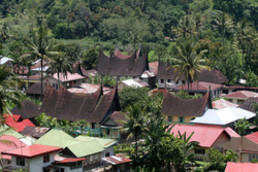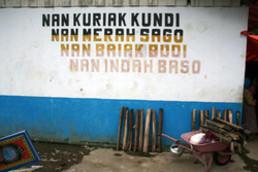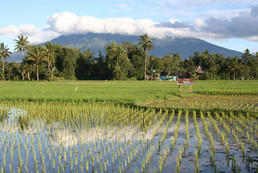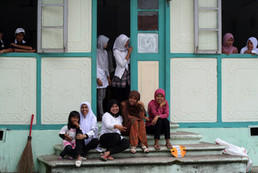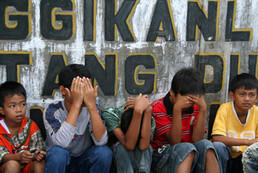Information on our work among the Minangkabau
Source: Susanne Jung
Source: Susanne Jung
Source: Susanne Jung
Source: Susanne Jung
Source: Susanne Jung
The Minangkabau on the Indonesian Island of Sumatra
The Minangkabau live on the Indonesian Island of Sumatra in the province of West Sumatra. Movements of populations from Taiwan to Southeast Asia have been well documented from as early as 500 B.C.. This explains why the Bahaso Minangkabau language (Minang) belongs to the West Austronesian family of languages – as do the languages spoken by the Malagasy Bara and the Tao living on the Taiwanese island of Lanyu.
Within the West Austronesian language family, Bahaso Minangkabau is closest to Malay. The Bahaso Minang language contains countless dialects, found in various regions and at times even in neighboring villages. Today, in addition to the spoken language of Bahaso Minang that is used in West Sumatran families and villages, the lingua franca Bahasa Indonesia is used primarily in written communication, though it also is spoken in formal contexts, such as in schools.
Geography and economic context
The core area of Minangkabau settlement is located between the highland towns of Payakumbuh, Batusangkar and Solok in the volcanic Barisan mountain range, at an altitude of about 900 meters above sea level. The climate is subtropical and there is high precipitation year round. Once densely forested, the highland areas have been cleared for settlement along the roadways, and cultivated for agriculture.
Today, terraced rice fields dominate the mountainous landscape. Other crops include cinnamon, yams, fruits and various vegetables, some of which is used for food but most of which is sold at local markets. In addition, cattle, horses and water buffalo are bred here. There is hardly any industrialized agriculture to be found. Rice is the staple food and thus plays a central role as a gift in traditional ceremonies such as weddings and funerals.
In addition, the Minangkabau are known for their high mobility as wandering laborers / merantau. Minang men are especially likely to accept offers of work on other Indonesian islands or abroad. Sometimes the core family comes along, but more often women remain behind with their children, staying with their parents in their home villages. The husband has the status of a guest when he visits.
Social and religious structure
The Minangkabau are Moslems and their stratified society has a matrilineal clan structure.
This contrasts with the social organization of the Bara and Tao. The apparent clash in the association of matrilinealism with Islam has sparked anthropological interest in the Minangkabau in recent decades. Rules of matrilineal descent strengthen the social position of Minangkabau women, an aspect seen as contradictory to the "patriarchal bias" of Islam (Blackwood 1995).
The matrilineal organization of society also determines the structure of the household which consists of a woman, her unmarried daughters and younger sons.
In these matrifocally organized households, husbands traditionally have the status of guests, meaning that they typically have no decision-making power; as far as the household and children go, they are “only” responsible for providing for the needs of the children.
Instead of the father, it is the “mamak,” the brother of the mother, who is described in literature as the decision maker for his nieces and nephews. But in the context of current social realities, this central role of child rearing increasingly appears to be assumed by biological fathers, who develop close emotional ties to their own children.
In the highlands of West Sumatra, the Islamic faith is quite central in both urban and rural contexts. Thus daily family routine is dominated by and structured according to religious observances. The workday is organized along the schedule of the five daily prayers, and Friday is observed as an Islamic holiday. Children learn to read and write in Arabic in kindergarten as their first foreign language, and they begin reading the Qu’ran. Only when they are able to read the holy scripture independently are Minangkabau permitted to marry. With time, more Arabic words are entering the vernacular. Girls must wear a headscarf in formal situations, such as upon entering kindergarten and at school. Once married, women must also wear a headscarf in public. Moreover, the male and female spheres of public life are strictly separated.
Field research:
The first field research, conducted from June 2009 to August 2010 in the core rural Minangkabau area between the towns of Bukittinggi and Payakumbuh, was primarily explorative in nature. The community chosen for study had a government primary school. The population numbered 247 people, including 56 households and 5 of the 12 clans that make up the Minangkabau ethnic group.
The field study included 47 village children (21 ♂; 26 ♀) ranging in age from 0 to 12 as well as 60 children of primary-school age (6-13 years old) from the neighboring communities.
The second field research period is to begin in January 2012 and runs through March 2012 in West Sumatra, following the preliminary analysis of data from the first study. Key topics include an in-depth examination of the socialization and development of the emotions of malu (shame) and marah (anger / rage).
